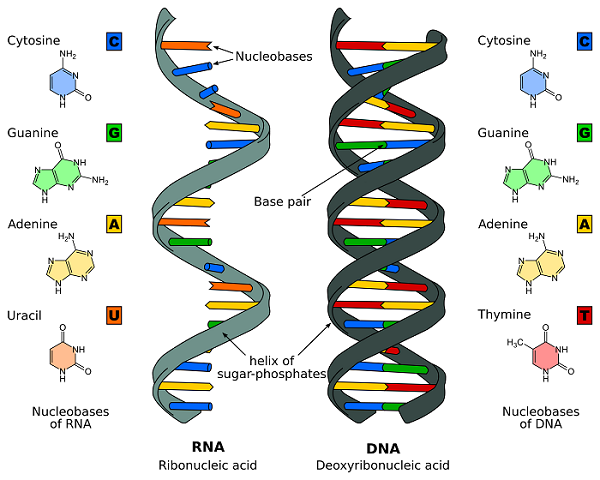All living organisms contain a complex organic compound called nucleic acid. Johann Friedrich Miescher (1844-1895), a Swiss biochemist, discovered nucleic acids in 1869. He found out that the cell nuclei contained a rather unusual compound and he named it nuclein. The unusual nature of the compound was brought about by the presence of phosphorus and nitrogen, as well as oxygen, hydrogen and carbon. This made nuclein among the first organic compounds discovered to contain that combination of elements. However, further research showed that different types of nuclein were present in different parts of a cell. For this reason, the name was modified to its present name - nucleic acid.
What Are Nucleic Acids?
Nuclei acids are large biomolecules or biopolymers that are vital to all living organisms. The many examples of nucleic acids including RNA (ribonucleic acid) and DNA (deoxyribonucleic acid) are composed of monomers called nucleotides. A nucleotide contains 3 components: a nitrogenous base, a phosphate group and a 5-carbon sugar. If the sugar is ribose, then its polymer is RNA. If it is deoxyribose, then its polymer is DNA.
Nucleic acids and proteins are definitely the most essential biological macromolecules. They are both found in plenty in all living organisms where they are responsible for encoding, transmitting and conveying genetic information, which means information is transported via nucleic acid sequence or via the arrangement of the nucleotides in the RNA or DNA molecule. Nucleotide strings are strung together in a particular sequence, which is a mechanism that enables storage and transmission of both genetic and hereditary information through protein synthesis.

Examples of Nucleic Acids
There are different types of nucleic acids with different characteristics and functions.
1. DNA
DNA holds the genetic information which is important in the functioning and development of all living things. The genetic information carried on the DNA segments is called genes. DNA is made up of two polymers that are formed by smaller units called nucleotides. The polymers have backbones made of phosphate and sugar combined by ester bonds. The polymers are not parallel as they run in opposite directions. Each sugar has one out of 4 molecules called bases (nucleobases) attached to it. Information is encoded by the sequence of the 4 neuclobases. A genetic code is used to read the information and elaborates the arrangement of amino acids in proteins. A process called transcription is used to read the code. Stretched DNA is copied to RNA, a related nucleic acid. DNA is stored in cell organelles called chromosomes. For Achaea and bacteria, DNA is stored in cytoplasm while in plants, fungi, protists and animals the DNA is stored in the cell nucleus.
2. RNA
RNA is another example of nucleic acids. The main function of RNA is to convert the genetic information encoded in the genes into amino acid sequences of proteins. There are three main types of RNA: ribosomal RNA (rRNA), messenger RNA (mRNA) and transfer RNA (tRNA). Ribosomal RNAcatalyzesthe peptide bond formation and is also a vital element of the ribosomes.As the name suggests, messenger RNA carries the genetic sequence of information from DNA to the ribosomes and directs protein synthesis. Transfer RNA decodes mRNA and it is a carrier of the amino acids that are used in protein synthesis. Besides, there are some other newly known types of RNA.
3. Artificial Nucleic Acids
Scientists have been able to synthesize nucleic acids in the laboratory for research purposes. They create analogue structure to RNA and DNA. This is mostly done in the molecular biology and medical fields.
4. Mutations of Nucleic Acids
Nucleic acids are so vital in the body that if any form of mutation occurs, it can be fatal. There are several conditions that can result from mutations of nucleic acids. Examples of the most common mutations include:
- Diseases of the muscles and the heart: When mutation occurs in the mitochondrial DNA, organs and tissues start to weaken, which is painful and can cause death.
- Cancer of the breast: This is caused by mutation of genes BRCA2 and BRCA1.
- Cancer of the ovary: Genetic mutations that cause breast cancer are also linked to ovarian cancer.
- Alzheimer's disease: Mutation of 3 genes linked to Alzheimer's are Presenilin-1, Presenilin-2 and APP.
- Down syndrome occurs as a result of mutation of genes in the DNA.
- Cystic fibrosis is a hereditary condition and attacks the secretory glands responsible for sweating and producing mucus.
- Color blindness is a result of mutation in the DNA and occurs mostly in men, making them unable to distinguish colors.
- Cri-du-chat occurs when chromosome 5 is absent.
- Tay-sachs disease mostly affects children at a tender age. They do not live long afterwards.
Get Needed Nucleic Acid from Your Diet
Examples of nucleic acids can be acquired from food once it is broken down. It helps in building up your DNA. Nucleic acids are typically in all cells thus present in all foods. Here are some foods that are rich in nucleic acids:
1. Fish
Fish contains a number of cells that have large quantities of nucleic acids. Fish also provides the body with healthy proteins that can be used in building human cells and tissues. Fish will also give you healthy fats in form of omega-3. Examples of such fishes are salmon, tuna and sardines.
2. Fruit
Fruit is a great source of nucleic acids. Each cell in a fruit has plenty of nucleic acids from the skin, flesh to the seed. Fruits also offer fiber and natural sugars. Examples of such fruits are mangoes, pears and apples.
3. Beans and Legumes
Legumes and beans are rich in nucleic acid. In addition, they contain a high level of proteins and dietary fiber. Beans and legumes promote healthy structure of your cells and muscles. Examples include clovers, peas and lentils.
